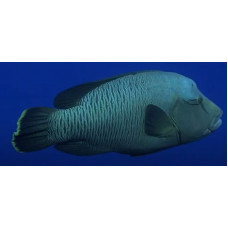Latin name
Cheilinus undulatus
Other names
Māori wrasse, Napoleon wrasse, Napoleon fish.
Identification
Adult fish have thick, swollen lips and a prominent bulge on the head.
This species is characterised by the following features: the body is deep, its depth is 2.2-2.7 times the standard length; the dorsal profile of the head is straight up to the level of the eye, then it becomes convex; adults have a large tubercle on the forehead, which may protrude in front of the eyes; the front part of the head forms an acute angle; the jaws and lips are protruding, each jaw has 2 strong canines in front; there are no enlarged teeth in the rear part of the upper jaw.
Lateral line interrupted below posterior part of dorsal fin base, with a total of 22-23 porous scales; scales extending to base of dorsal and anal fins; scales anterior to dorsal fin extending anteriorly to centre of eyes; cheeks and elytra scaled; mandible unscaled.
Features of fish fins
Dorsal spines (total): 9; Dorsal soft rays (total): 10; Anal spines: 3; Anal soft rays: 8. The dorsal and anal fins of adults are very pointed, extending well beyond the base of the caudal fin. The pelvic fins reach the anus in small fish and extend beyond the anal fin in large individuals. The caudal fin is rounded.
Fish colouring
Body colour olive to green with a vertical dark band on each scale above and behind the pectoral fins. The head of adults is blue-green to blue with very irregular wavy yellowish lines. There are two black lines behind the eyes. Juveniles are pale to white with dark scale bands and conspicuous black lines behind the eyes, 2 lines running diagonally upwards and backwards from the eyes, and 2 lines running diagonally downwards on the snout in front of the eyes.
Distribution
Indo-Pacific: from the Red Sea to South Africa and the Tuamoto Islands, north to the Ryukyu Islands, south to New Caledonia.
Habitat
Marine tropical species associated with reefs, depth range 0-100. Adults inhabit steep outer slopes of reefs, channels and lagoons, and benthopelagic areas. They are usually solitary, but may occur in pairs. Juveniles are found in coral-rich areas of lagoonal reefs where Acropora staghorn corals are abundant, and on reefs with seaweeds or sea grass beds.
Size
Fish up to 230 cm in length is the largest representative of the gubanovyh. The maximum weight is 191 kg. However, more often the length is 60 cm. Maximum reported age: 32 years.
Behavior
It is a solitary and territorial fish. It sleeps between corals at night. Adults roam the reefs during the day and rest in reef caves and under coral ledges at night.
Food and feeding habits
It feeds on fish, molluscs and crustaceans. It is one of the few predatory fish that can eat poisonous species.
Reproduction
The fish matures at a length of 35 cm. They lay eggs and mate during reproduction.
Fishing
This species is caught by hook, line and spear and is sometimes used for food. There have been reports of ciguatera poisoning.
Relationship with a person
They are not afraid of humans.
This fish is threatened with extinction in the medium term unless effective measures are taken to prevent overfishing. It is mainly traded through Singapore and Hong Kong.
Juveniles can sometimes be seen in aquariums.
| Classification | |
| Phylum | Chordata |
| Class | Actinopterygii |
| Squad | Labriformes |
| Family | Labridae |
| Genus | Cheilinus |
| Species | C. undulatus |
| Features | |
| Conservation status | Endangered |
| Habitat | Pelagic |
| Life span, years | 32 |
| Maximum body weight, kg | 191 |
| Maximum length, cm | 230 |
| Sailing speed, m/s | Least Concern |
| Threat to people | Edible |
| Way of eating | Predator |
Humphead wrasse
Tags: humphead wrasse



